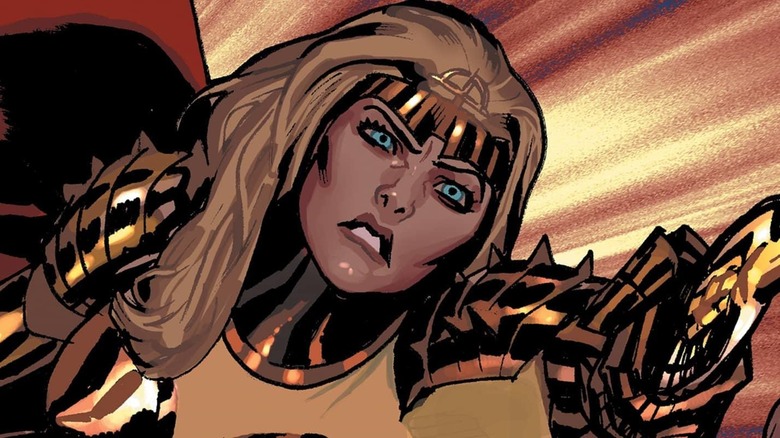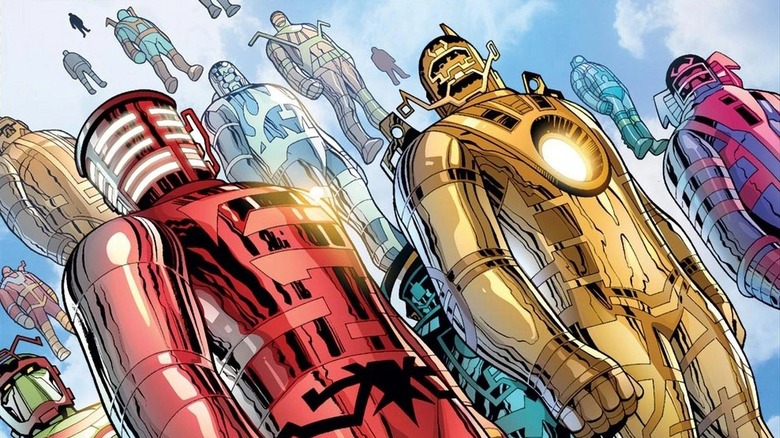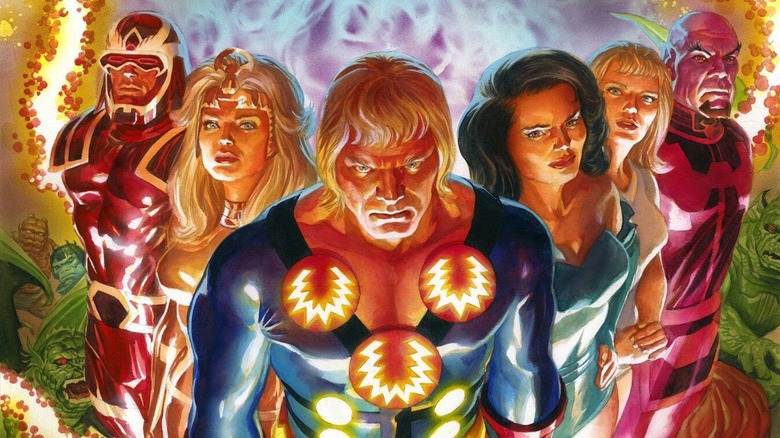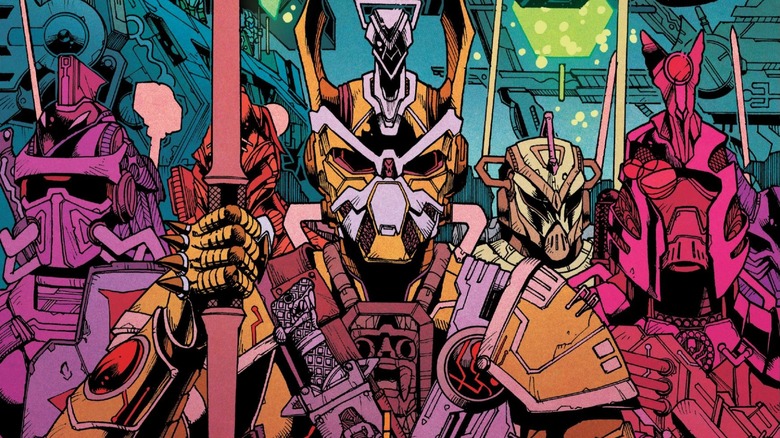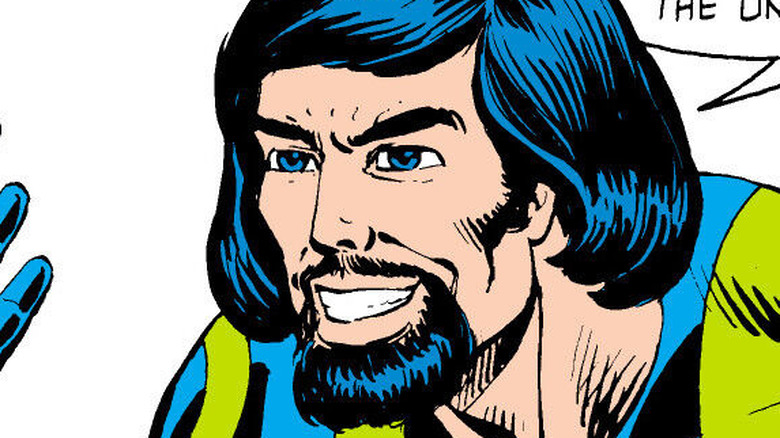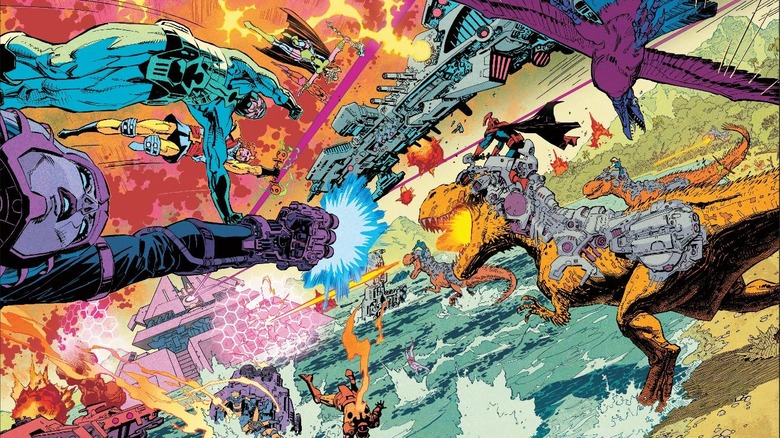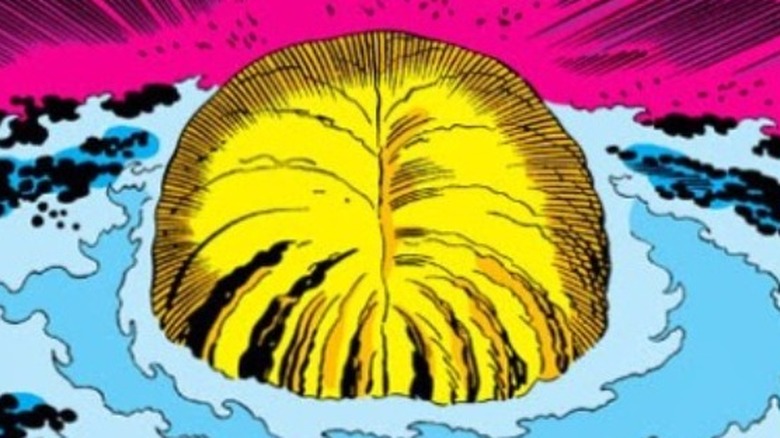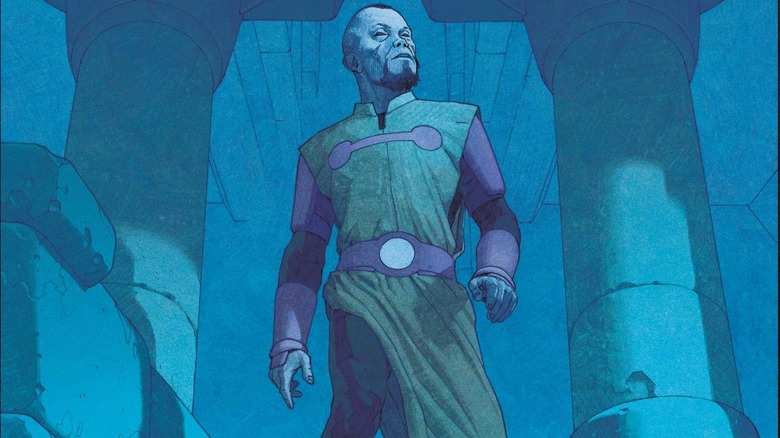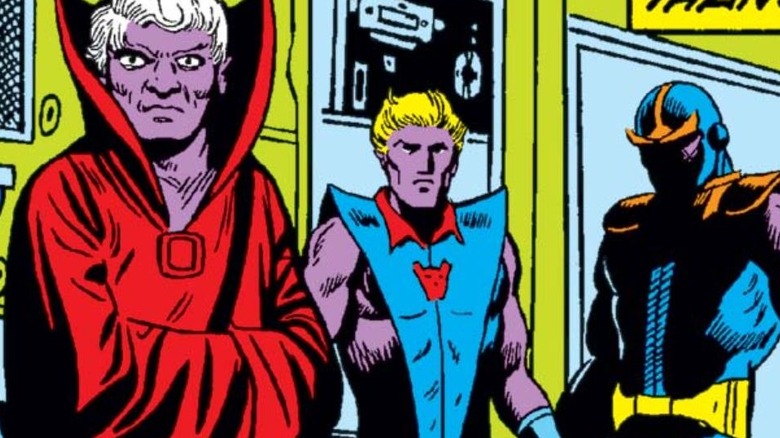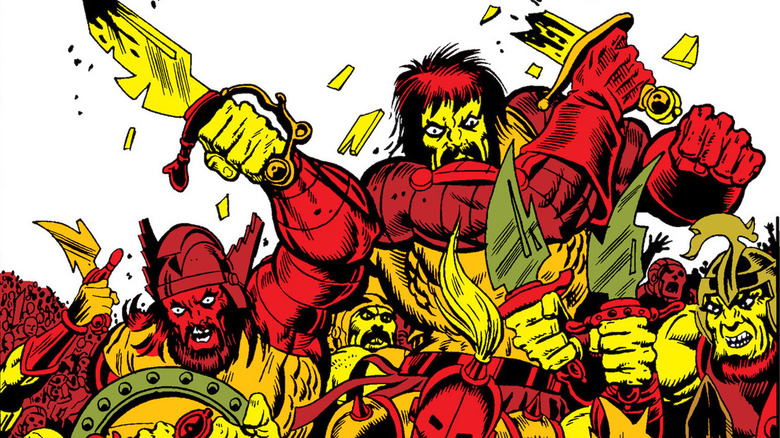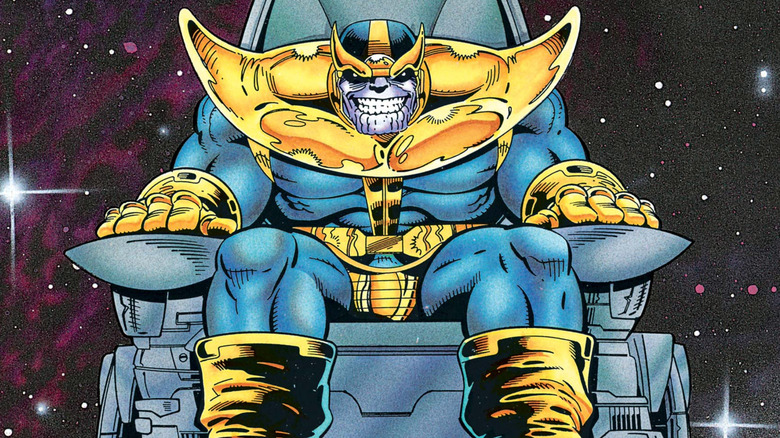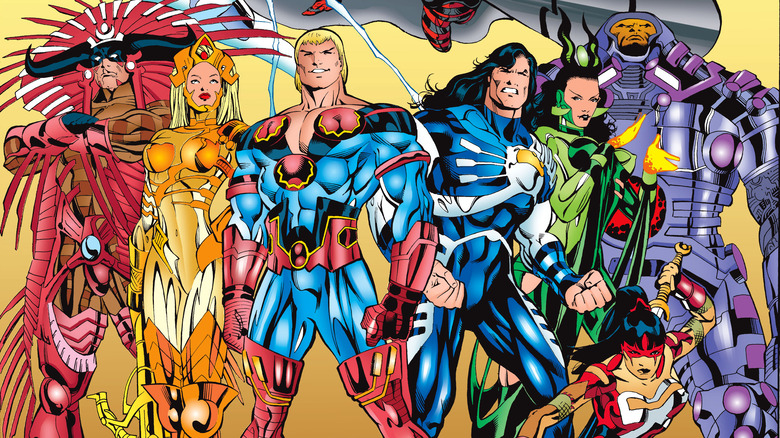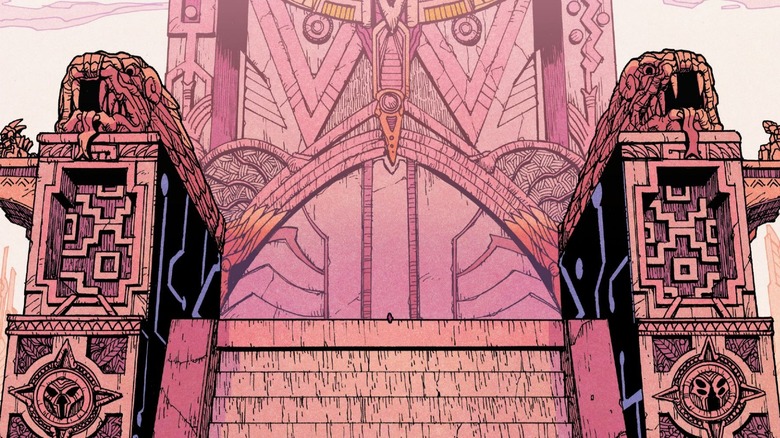The Four Eternals Teams Fully Explained
When Marvel Studios announced they were making a movie based on "The Eternals," many fans, both new and old, were exposed for to the property for the first time. Much like James Gunn's "Guardians of the Galaxy" films before it, even many long-time comic book fans were unfamiliar with the team. "The Eternals" meant something new was coming to both the Marvel Cinematic Universe and the comics, and that's an exciting thing.
It also begs the question: who were the Eternals in the comics before this film, and what was their story? Well, the first step in answering that question is realizing that the Eternals aren't a traditional super-hero team. Like the Inhumans that came before them, the Eternals are essentially their own separate human species and, as such, have splintered into various political factions throughout their history. Because of this, there are four primary teams of Eternals that are important to understanding their history.
The Celestials' First Host
Approximately 1,000,000 years ago, the Celestials visited Earth for the first time after the homo erectus human species first appeared on the planet. Fascinated by the genetic potential of these creatures, the Celestials First Host of visitors to the planet experimented on these early humans to create two new, distinct subspecies: the Deviants and the Eternals.
The Eternals were immortal beings imbued with cosmic energy and a host of incredible abilities. They were superhumanly fast, strong, agile, and durable. They could fly, had limited degrees of telepathy, and could manipulate cosmic energies to devastating degrees. Individual Eternals would master, utilize, or specialize some of these powers more so than their brethren, but all of them were extraordinarily powerful.
The Deviants were something altogether different. They were very mortal, usually looked fairly monstrous, and were typically far weaker than their cousins, but unlike the Eternals, the Deviants could reproduce and change. This was the Deviant's greatest advantage; their potential for mutation could allow them to give birth to horrific monsters of incredible power, and it was the Eternal's job to keep them in check.
The Celestials created 100 members of each species and then left for parts unknown to let their experiment run its course.
The Eternals, United
In the beginning, the Eternals were united by their leader, "Prime Eternal" Kronos, and their three principles established in 2021's "Eternals" #1: "Protect Celestials. Protect the Machine. Correct Excess Deviation." They were the keepers of the Celestial's grand experiment, and to this end, they established their first and greatest city, Titanos, somewhere in North America.
Here they remained and worked together to monitor the progress of both humanity and the Deviants alike. Though the Celestials' absence meant they had little opportunity to enforce the first principle, they had to work constantly to follow the second and third.
"The Machine" was an extraordinarily advanced artificial intelligence entrusted to the Eternals by their masters that organized their lives, cataloged their findings, and generally watch over the planet and its people. The Machine's personality generally thought of itself as being the literal planet Earth itself, and thus, the Eternals were ultimately entrusted with protecting the planet as a whole.
The Machine was also responsible for maintaining one last, crucial aspect of the Eternals' lives: "the Machines of Resurrection." Though the Eternals were ageless, they could still die, but thanks to these machines, death was a mere inconvenience. Ultimately, they would be reborn into a new body with all their memories intact.
This is how the Eternals functioned for the first 400,000 years of their history. They were one people united under one singular purpose, but this would not last.
The First Civil War
After roughly 400,000 years of peace and prosperity, the 100 Eternals were divided by ideology for the very first time. Though Kronos believed that their species should continue in their roles as removed overseers of mankind's development, another Eternal named Uranos believed they should use their vast powers to conquer the earth and rule humanity directly, guiding their evolution however they saw fit.
This was seen as heresy, as a direct betrayal of the three principles. The Eternals weren't meant to directly interfere in the day-to-day affairs of mankind, but when Uranos refused to back down, Titanos was engulfed in civil war. This conflict would come to be known as the Uranosian War, and it was absolutely brutal. The Eternals were all incredibly powerful, had several hundred thousand years of combat experience, and were simply reborn any time that they died, so the war could, in theory, last forever as the Eternals killed each other over and over and over again.
Eventually, however, Kronos managed to defeat and capture Uranos in single combat, and his followers finally lost the will to fight. In the end, two dozen Eternals refused to recant Uranos' heresy, and they were exiled to the planet that humanity knows today as Uranus. The war was over, but it had come at a cost. There were now only 76 Eternals left on earth, and the first separate team had been formed.
The Uranite Eternals
These "Uranian" or "Uranite" Eternals were the first separate team of Eternals and are the first of the four primary teams that fans should become familiar with. After landing on the far-flung planet, they discovered a seemingly abandoned Kree outpost that was guarded by a lone Kree Sentry. Though powerful, the two dozen Eternals easily dispatched the lone alien robot and took over the outpost for themselves.
Desperate for revenge, Uranos led his Eternals to create a new spaceship so they could return to earth and begin their war anew. This might have been the end of the Uranite Eternals if four of them, led by one named Astron, hadn't refused to follow Uranos any longer and chosen to stay behind. Uranos and his remaining nineteen followers left the planet, and the four remaining Eternals formalized their small colony and met the native Uranian species.
Though these Uranians allowed the Eternals to remain in peace, they did so on one condition: if they tried to leave, they would be destroyed. Thus these four Eternals would remain for several hundred thousand years.
The first attempt to settle Titan
Uranos and his remaining followers would not fair well. Not long after leaving Uranus in their ship, a Kree fleet arrived to investigate the disturbance at their outpost and attacked the Eternals' ship. After a brief space battle, the Kree emerged victorious and the Eternals crash-landed on Saturn's largest moon, Titan. Though other Eternals would eventually make Titan their permanent home, this group's colonization efforts would ultimately fail.
Though none know why, this colony would eventually lose itself in another civil war. Without direct access to earth and the Machine, these Eternals could not be reborn, so as they died throughout the course of their war, they stayed dead. This is likely why the history of this war, its sides, and its reasons were lost to time, as in the end, Uranos and his followers would all die with one exception: a female Eternal named Sui-San.
The Final Schism
100,000 years after their first Civil War, the first Prime Eternal, Kronos, discovered how to essentially become a god. The process nearly destroyed his city, Titanos, but it worked, and Kronos ascended to the heavens while also greatly enhancing the remaining Eternals of earth. With Kronos beyond the earthly realm, Zuras was selected as the new Prime Eternal to the chagrin of his "brother" A'Lars.
This fracture would remain for another 300,000 years until the Titan Schism splintered the Eternals one last time. Where their first civil war was fought to answer the question of interference, this war revolved around the debate over reproduction. Zuras, like his "father" before him, believed the Eternals should remain as they have always been, but A'Lars believed that it was their duty to reproduce and create new Eternals to replenish their losses.
After yet another brutal war, the Eternal's capital city, Titanos, was completely destroyed, and peace was finally reached. A'Lars would be allowed to carry out his reproduction experiment on Titan with its last remaining Eternal, Sui-San, and the outcome of the experiment would determine who was correct.
Despite the restoration of peace, Titanos' destruction would leave the Eternals fractured for millennia to come as they separated into different cliques and resettled in separate cities across the planet.
The Olympian Eternals
The most traditionally heroic of these cities was Olympia. Founded near Mount Olympus in Ancient Greece, these Eternals eventually created an alliance with the Greek gods and sometimes acted as their agents on earth, often causing the two groups to be mistaken for the other. Because Prime Eternal Zuras lived here, Olympia was essentially the unofficial capital of the earth-bound Eternals, though they never had that formal of a political system.
Their comic book stories are typically set out of Olympia, so it's the most explored and well-established team that fans should get to know, and as a result, most of the Eternals moviegoers meet in the film live in this city. Gemma Chan's Sersi, Kumail Nanjiani's Kingo, Lia McHugh's Sprite, Brian Tyree Henry's Phastos, Lauren Ridloff's Makkari, Angelina Jolie's Thena, and Don Lee's Gilgamesh are all primarily associated with Olympia, and both Richard Madden's Ikaris and Salma Hayek's Ajak end up moving here by the 21st century.
The Polar Eternals
The Polar Eternals are their third team and their second major settlement on earth. Though they did not wish to leave for Titan, they were also tired of their cousins in Olympia and so decided to strike out by themselves and found their own settlement: Polaria. The denizens of this town tended to be more pragmatic and ruthless than their sister city in Greece, and the two groups often struggled to establish who between them was the more dominant power, though their rivalry has yet to escalate to open war.
The inhabitants of this city are not evil, by any means, but they have a distinctly different temperament than the Olympia Eternals, and, as 2021's "Eternals" #4 explains, this has led to a sort of cold war between the two that has lasted for several hundred thousand years, though attempts have been made to ease those tensions. Richard Madden's Ikaris, for example, was a Polar Eternal who moved to Olympia to become their lead tactician, giving Polaria assurances that they wouldn't be attacked while also providing a powerful Polarian a sacred duty to his former competition.
Barry Keoghan's Druig and Salma Hayek's Ajak are also traditionally Polar Eternals in the comics.
The Titanian Eternals
The fourth and final team of Eternals took awhile to get off the ground. Having lost the civil war, A'Lars, now going by the name Mentor, traveled to Saturn's largest moon, Titan. There, he found the remnants of the previous settlement and its sole survivor: Sui-San. 2021's "Eternals: Thanos Rises" #1 shows that, together, they used clones, genetic experiments on colonizing aliens, and other constructs to create a race of disparate beings that all had some amount of "Eternal biological technology written in their cells."
Despite the civilization they were able to form, A'Lars and Sui-San didn't view these creations as true Eternals, and after pleading with the now-cosmic Kronos for help, the former Prime Eternal gifted the couple a pair of quantum bands. First introduced in "Fantastic Four" #164 in 1975, these devices were the staple instrument of the Protectors of the Universe, and they granted their wearers incredible cosmic powers. Reduced to the size of wedding rings by Kronos, however, wearing the bands allowed A'Lars and Sui-San to finally conceive two true, Eternal children: Eros, the Avenger known as Starfox, and Thanos, the Mad Titan.
Uranus destroys their Eternals
After millennia spent trapped on Uranus, the four final Uranite Eternals still trapped there were beyond ready to leave, no matter what the native Uranians had to say about it. To this end, in the early twentieth century, these Eternals established contact with an earth scientist named Matthew Grayson and showed him how to build a rocket that would allow him and his son Robert to escape Nazi Germany by flying to Uranus. After they arrived, the Eternals raised Robert as one of their own and continued to monitor Earth for a good time to make their escape.
When they observed the rise of Captain America during World War II, they decided to mold Robert into the image of a superhero and send him to earth as their agent. To this end, they put the boy through rigorous training, equipped him with their own set of quantum bands, and sent him to earth as Marvel Boy in the year 1950.
Despite gaining some fame after Timely Comics began publishing his adventures, Robert soon decided that earth needed to find its own path without extraterrestrial interference and refused to work as the Uranite Eternals agent any longer. Enraged, these final four began plotting to return to earth themselves, but they were completely and utterly destroyed when the native Uranians caught wind of their scheme and carried out their original threat.
Thanos ravages Titan
From the moment he was born, Sui-San knew that Thanos was demented, and the boy proved her right with every moment of his life. Though he was born, in theory, a true Eternal, his body was more-or-less infected with a Deviant Syndrome that mutated his physique into the purple behemoth that fans know from "Infinity War" and "Endgame."
As a young boy growing up among the Titanian Eternals, Thanos secretly began murdering and dissecting various creatures to study their genetic code. Wishing to understand his own Deviant biology, he committed the first two murders on Titan as a teenager in order to study their corpses. After failing to learn what he needed to know after 17 more attempts, he kidnapped, murdered, and dissected his own mother as retold in 2021's "Eternals: Thanos Rises" #1.
Disillusioned by existence, Thanos left Titan and wandered the galaxy, killing entire planets and amassing a large fleet as he went. When Death finally revealed herself to Thanos, the Mad Titan fell in love and returned to his home world to burn it to the ground in her name. After bombarding Titan from orbit, Thanos descended to its surface to kill any survivors he could find, leaving only his father, Mentor, alive so he could live to see the evil his experiment had wrought. Though Eros also escaped this annihilation, the Titanian Eternals were no more.
Then there were two
With the final destruction of both the Uranite and Titanian settlements, there were only two major "teams" of Eternals left by the early 21st century: Polaria and Olympia. These are the two teams that appear in most Marvel stories set in the "present day."
When the Celestials Fourth Host began approaching earth to judge the result of their experiment in the first six issues of Jack Kirby's original 1976 "Eternals" comic book series, it was these two teams of Eternals who united alongside the Deviants to reveal their existence to the world. When the Celestials arrived in 1980's "Thor" #300 and 301, the Eternals allied with Odin and some Earth's mightiest heroes to stand up to the Celestials who ultimately deemed their test a success and left the planet unharmed.
These Eternals would continue to interact with the earth and its heroes as the years went on. They studied and monitored the birth of mutants, the fourth and final species of humanity that the Celestials had seeded the potential for 1,000,000 years ago, and Sersi, Gilgamesh, and Eros — under the name of Starfox — would even join the ranks of the Avengers for a period of time.
The many other related teams
It is important to note that though there are only four major teams of Eternals in the Marvel Universe, there are a number of other minor teams and settlements of both Eternals and similarly related groups. For example, the Celestials made Eternals out of other species across the galaxy, including both the Skrulls and the Kree.
There were also two other minor settlements on earth: Celestia and Oceanus. Celestia was a religious site where both the Polar Eternal Ajak and the Olympian Eternal Makkari served as priests attempting to understand the Celestials who made them. Though Oceana was originally mentioned in 1983s "Official Handbook of the Marvel Universe" #4, it's virtually unknown. Based on the name, it was probably founded by Oceanus, the Eternal who helped Kronos win his war against Uranos, but the city has never appeared in a story, though 2021's "Eternals: Thanos Rises" #1 mentioned that some revived Uranite Eternals had moved there.
Though not proper Eternals, there were some other related groups that are relevant as well. The Deviants, for example, lived in a large underground settlement called Lemuria. Additionally, 1992's "X-Force" #10 introduced the "Externals," a sort of X-Men version of Eternals that consisted of nine immortal mutants, including the famous villain, Apocalypse, who were all permanently linked to one another. Together, they sought to manipulate the political and economic forces of the world and conquer it.
